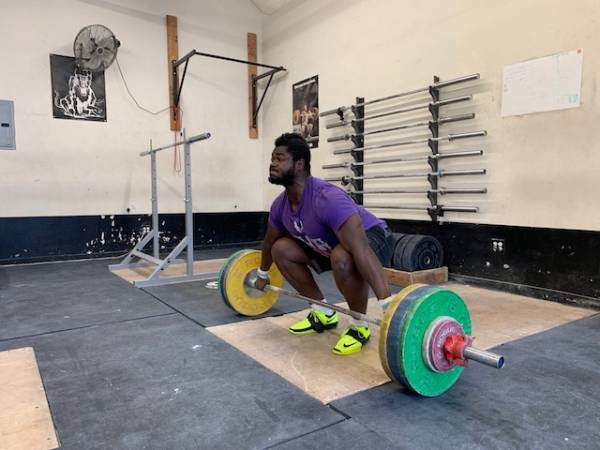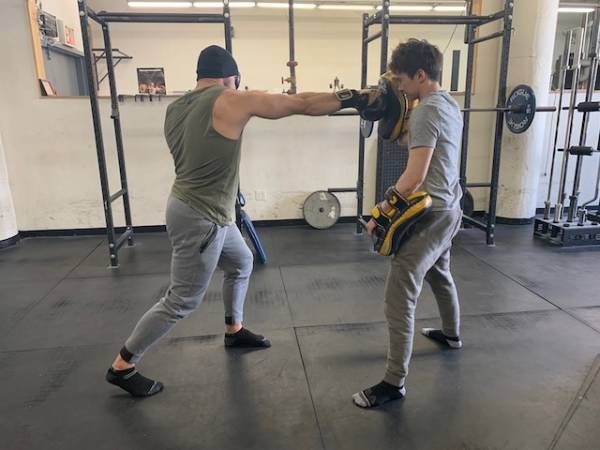Let me tell you what’s improved my Olympic weightlifting technique, and that of the lifters I coach more than anything else — focusing on balance, specifically keeping the pressure on the mid-foot on the first pull of the snatch and clean.
Let me tell you what’s improved my Olympic weightlifting technique, and that of the lifters I coach more than anything else — focusing on balance, specifically keeping the pressure on the mid-foot on the first pull of the snatch and clean.
I’ve had the good fortune of having, Russian champion Olympic weightlifter Vasily Polovnikov, make his home at my gym, JDI Barbell. He’s been coaching here for almost a year now, and I’ve learned nuances in weightlifting technique I previously wasn’t even aware. But one of the broader principles that I’ve seen him emphasize that has the most significant influence in refining the lifts is this prioritization of mid-foot balance over anything else.
According to Vasily
According to Vas, most of the errors in weightlifting stem from not beginning the pull with the correct balance. He goes to great lengths to adjust foot position, starting hip height and even hand placement to make sure that whoever he’s coaching finds the correct balance before the bar lifts from the floor. He’ll have lifters rock back and forth from their heels to their toes while pulling the slack out of the bar before they pull.
Vasily thinks it’s pointless to tell someone to pull longer or extend harder or stay over the bar or drive from their legs if their balance is not first correct. He insists that it is impossible for the lifter to correct any of these other faults if the balance is even slightly off but instead claims that once this is fixed most of the cues will not be needed anymore.
I’ve seen many coaches insist on proper foot pressure and balance, but never to the degree that Vas does. In his mind, it seems, if this isn’t perfect there is no point of adding any weight to the bar.
Solving the Balance Issue
In my lifting and my coaching, the more emphasis I put on solving this balance issue, by any means necessary, the better and more instinctive the lift becomes. I feel my legs engaging and driving the bar upwards.
My body stays in position over the bar until the bar makes contact against my legs or hip. My body reacts in a correctly timed effort as my traps and ankles explosively contract and the bar is placed onto my shoulders or overhead. And my lifters say they feel the same. The whole is made better from the start, the precise start.

Into Fluidity
I recently took up Muay Thai training. I used to do some boxing when I was young but this practice, with all the different variations in striking, is very stimulating to me. I started practicing it at my gym when my buddy Justin Troy, an established Muay Thai fighter and coach, started coming in for strength and conditioning training with me.
I’d coach him, and then he’d coach me, a good barter. Then he brought me to his gym- Sitan Gym NYC, where I’ve been practicing since.

A basic skill that’s practiced when throwing a punch is the turning of your fist right before it makes contact. This means that first, your fists should face each other when they’re up guarding your head and that it shouldn’t completely turn, so that the knuckles are parallel with the ceiling, until right before impact.
This provides the snap and sting of a well-timed, well-practiced punch. Most people have difficulty doing this, and I was no different when I started, despite my background. It had been a while since I practiced a punch and it’s a skill that degrades over time.
Justin would coach this technique in me by telling me first to make sure that my gloves were touching my head with my palms facing each other. He focused on the start. Then Justin told me to focus on the image of lighting a match off of my head. He told me that when beginners throw a punch, they immediately turn their fist from the start because they know that when the fist hits, the knuckles should be up.
But if you think of lighting the match, your palm stays facing in, and it provides that flicking effect where it turns at the last second. Justin focuses on teaching the starting position, and initial movement, and it leads to an intuitive effort from the beginning to the completion of the punch.
Consider Your Start
Most things depend on how you start them. If you half-heartedly begin something, it’s tough to change or increase the momentum of it. Take diets for example. Let’s leave out the kind of diets where you eliminate or count calories for the moment and talk about the conscious effort to eat according to specific guidelines and emphasize the importance of quality food and nutrient type.
Let’s say you like consuming high amounts of fats in the morning without carbs or that intermittent fasting makes you feel and perform well. It doesn’t matter what the focus is.
But let’s say you start this dietary habit, but that know full well that if you don’t throw out the bananas in your house, you’ll eat one on your way to work.
You’ll, of course, justify yourself, because we all do, and assure your split psyche that one banana is under a certain amount of calories or that the nutritional benefits of eating them outweigh the strict adherence to the guideline you set for yourself. But that’s not the point.
The point is that you still broke your fast. You had a carbohydrate that spiked your blood sugar. You willfully allowed yourself to begin something on a bad footing and already set a pattern that you’ll follow until you change your views on nutrition next month. And how you do one thing is how you do everything. Cliche as that may be, there’s hardly a more accurate remark.
Start everything in your life the proper way, or don’t start at all. In my experience, you do more bad than good if you stutter start or start on the wrong foot. But understand that the correct way for you right now isn’t necessarily the best way.
There may be a better way that you haven’t learned yet. All you can do is the best that you can with the framework you have now. Look as clearly as you can through your current lens but then retool and revise along the way as things become more clear.
Putting your best foot forward is more important than I used to think. I learned about the idea of failing forward, but I thought that I could take one-half step forward and still keep my other foot back in my circle of safety and familiarity. I talked myself out of taking a full step forward by consoling myself that I was cautious and strategic.
But don’t get this confused with the insecurity that you have to know everything first before you start, this has caused more hesitation in my life than just about anything else.
If you don’t know all there is to know, you must take that step with the sober judgment that you will have to face all these things and do the work needed to not only learn but to integrate the lessons into your current perspective.
Jesse competes in the sport of Olympic weightlifting, and he was also formerly a competitive powerlifter. He was featured in main strength and fitness publications. You can read more of his work on his website.






